The Intel Xeon W Review: W-2195, W-2155, W-2123, W-2104 and W-2102 Tested
by Ian Cutress & Joe Shields on July 30, 2018 1:00 PM EST- Posted in
- CPUs
- Intel
- Xeon
- Workstation
- ECC
- Skylake-SP
- Skylake-X
- Xeon-W
- Xeon Scalable
Benchmarking Performance: CPU Encoding Tests
One of the interesting elements on modern processors is encoding performance. This includes encryption/decryption, as well as video transcoding from one video format to another. In the encrypt/decrypt scenario, this remains pertinent to on-the-fly encryption of sensitive data - a process by which more modern devices are leaning to for software security. Video transcoding as a tool to adjust the quality, file size and resolution of a video file has boomed in recent years, such as providing the optimum video for devices before consumption, or for game streamers who are wanting to upload the output from their video camera in real-time. As we move into live 3D video, this task will only get more strenuous, and it turns out that the performance of certain algorithms is a function of the input/output of the content.
All of our benchmark results can also be found in our benchmark engine, Bench.
7-Zip 9.2
One of the freeware compression tools that offers good scaling performance between processors is 7-Zip. It runs under an open-source licence, is fast, and easy to use tool for power users. We run the benchmark mode via the command line for four loops and take the output score.
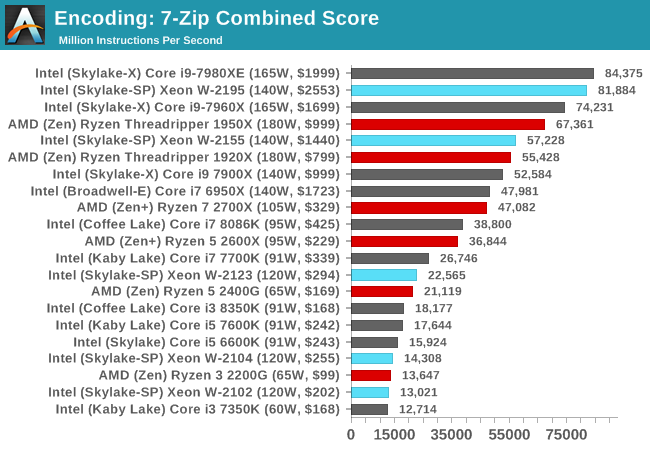

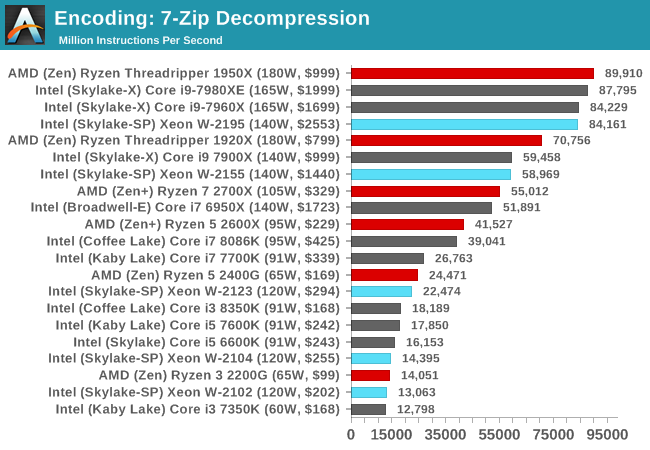
AMD's prowess in decompression means that it takes the top spot, however overall the W-2195 and the i9-7980XE are competing for top spot.
WinRAR 5.40
For the 2017 test suite, we move to the latest version of WinRAR in our compression test. WinRAR in some quarters is more user friendly that 7-Zip, hence its inclusion. Rather than use a benchmark mode as we did with 7-Zip, here we take a set of files representative of a generic stack (33 video files in 1.37 GB, 2834 smaller website files in 370 folders in 150 MB) of compressible and incompressible formats. The results shown are the time taken to encode the file. Due to DRAM caching, we run the test 10 times and take the average of the last five runs when the benchmark is in a steady state.
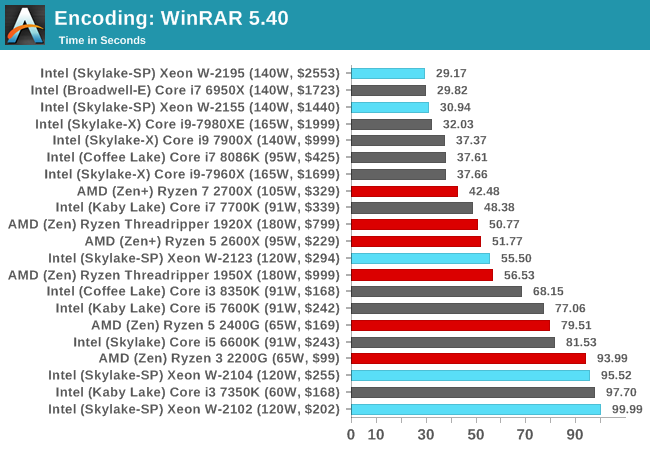
WinRAR likes cores and memory, and it seems that even the W-2155 can win against the Core i9-7980XE in this test. Despite the quad channel memory for the Xeon W quad core parts, the low frequency means they are bringing up the rear. The W-2123 hits mid-pack, actually beating the Threadripper 1950X in this test.
AES Encoding
Algorithms using AES coding have spread far and wide as a ubiquitous tool for encryption. Again, this is another CPU limited test, and modern CPUs have special AES pathways to accelerate their performance. We often see scaling in both frequency and cores with this benchmark. We use the latest version of TrueCrypt and run its benchmark mode over 1GB of in-DRAM data. Results shown are the GB/s average of encryption and decryption.

HandBrake v1.0.2 H264 and HEVC: link
As mentioned above, video transcoding (both encode and decode) is a hot topic in performance metrics as more and more content is being created. First consideration is the standard in which the video is encoded, which can be lossless or lossy, trade performance for file-size, trade quality for file-size, or all of the above can increase encoding rates to help accelerate decoding rates. Alongside Google's favorite codec, VP9, there are two others that are taking hold: H264, the older codec, is practically everywhere and is designed to be optimized for 1080p video, and HEVC (or H265) that is aimed to provide the same quality as H264 but at a lower file-size (or better quality for the same size). HEVC is important as 4K is streamed over the air, meaning less bits need to be transferred for the same quality content.
Handbrake is a favored tool for transcoding, and so our test regime takes care of three areas.
Low Quality/Resolution H264: Here we transcode a 640x266 H264 rip of a 2 hour film, and change the encoding from Main profile to High profile, using the very-fast preset.
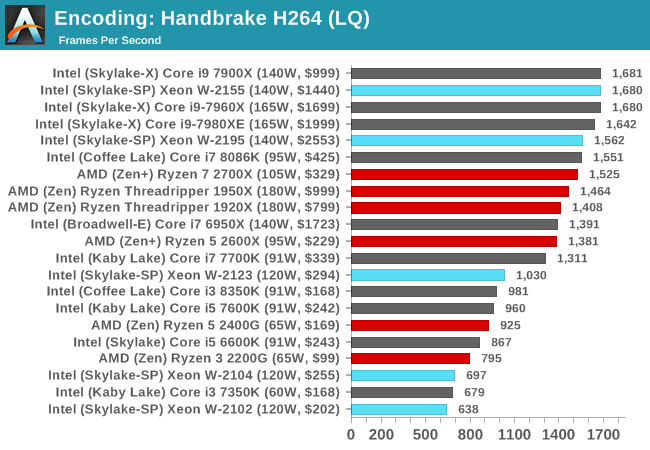
High Quality/Resolution H264: A similar test, but this time we take a ten-minute double 4K (3840x4320) file running at 60 Hz and transcode from Main to High, using the very-fast preset.
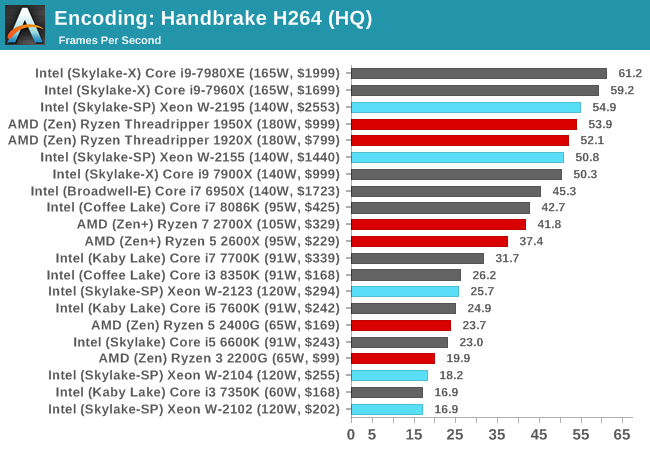
HEVC Test: Using the same video in HQ, we change the resolution and codec of the original video from 4K60 in H264 into 4K60 HEVC.
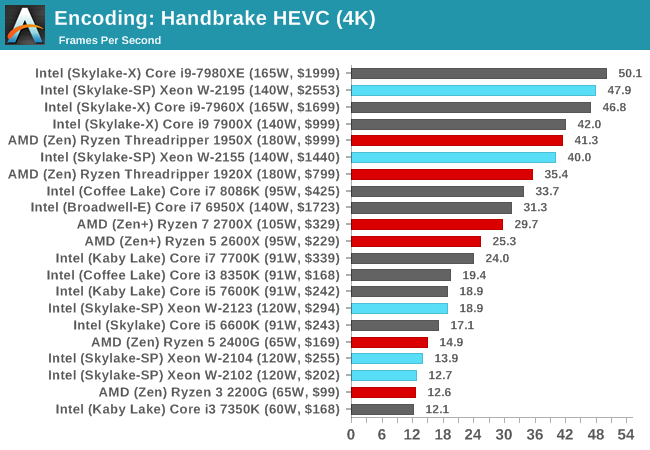










74 Comments
View All Comments
HStewart - Monday, July 30, 2018 - link
I am curious why Xeon W for same core count is typically slower than Core X - also I notice the Scalable CPU have much more functionally especially related to reliability. In essence to keep the system running 24/7. Also the Scalable CPU's also appear to have 6 channel memory instead of 4 Channel memory. I wonder when 6 channel memory comes to consumer level CPUs.One test that would be is to see what same core processor for Xeon W vs the Scalar CPU with only one CPU.
Another test that could be interesting is a dual CPU scalable with say 2 12 cores verses 1 24 core of CPU on same level.
Just test to see what it with more cores vs CPU's
duploxxx - Monday, July 30, 2018 - link
one threadripper 2.0 and you can throw all intel configs here into the bintricomp - Monday, July 30, 2018 - link
YeaHHStewart - Monday, July 30, 2018 - link
I wish people keep the topic to the subject and not blab about competitor productsduploxxx - Tuesday, July 31, 2018 - link
if you would know anything about cpu scalable systems you would not ask these questions. a 2*12 vs 1*24 will be roughly 20% slower if your application scales cross the total core count due to in between socket communication. Even Intel provides data sheets on that. No need to test.as long as intel can screw consumers they will not invest anything, you wont get 6 mem lanes in xeon W or consumer unless competition does it and they get nailed. btw why on earth would you need that on a consumer platform?
BurntMyBacon - Tuesday, July 31, 2018 - link
If all things are equal, then what you say is true. There is a known performance drop due to intersocket communications. However, you may have more TDP headroom (depends on the chips you are using) and mostly likely more effective cooling with two sockets allowing for higher frequencies with the same number of active cores. If the workload doesn't require an abundance of socket to socket communications, then it is conceivable that the two socket solution may have merit is such circumstances.SanX - Tuesday, July 31, 2018 - link
Why ARM is just digging its buggers watching the game where it can beat Intel ? Where are ARM server and supercomputer chips? ARM processors soon surpass Intel in transistor count. And for the same amount of transistors ARM is 50-100x cheaper then duopoly Intel/AMD. As an additional advantage for ARM these two segments will soon completely abandon Microsoft.beggerking@yahoo.com - Thursday, August 2, 2018 - link
ARM is RISC which is completely from CISC so applications and os are limited. Microsoft server os has really evolved in every aspect in the last few years that may take RISC years to catch up on the software side.JoJ - Saturday, August 4, 2018 - link
ARM is Fujitsu's choice of successor core to SPARC64+, a architecture Fujitsu invested decades of research and development and testing to offer both commercially and at a national laboratory supercomputing level. ARM is therefore not a knee jerk choice of direction for a very interesting super builder.Obviously you exaggerated a little bit, saying ARM is "50 - 100 times cheaper than AMD/Intel".
I wish I could shake my belief that pedantic literalism in Internet forums in general wasn't preventing broad discussion - we exaggerate in real life without any socially degrading effects, why not online?
OR ate your conversation parties sniffing that obviously -- any person who inadvertently speaks technically inaccurately despite forming perfectly understandable inquiry... as if they are unwashed know nothings, and turning on their heels to end the discussion.....a bit like HN's "we don't tolerate humor here" reactions to innocent attempts at lightening the thread...
but I digress, my point here is your comment above raised a couple of interesting questions, that I feel haven't been answered only because I think readers by themselves first over react to hyperbole, then infil the accepted wisdom to answer your questions, despite you ask about pertinent value critical concerns. I feel that by supplying the answer and dismissing the comment as uninformed, the most important thing happening is the reader voluntarily self reinforcing given marketing positions, and not engaging with the subject at all. I work in advertisingand am actually studying this, because advertising buyers adore this kind of"mind share" but we think that is at odds with the advertising buyers wanting"open minded, engaging, adaptable, innovative" customers.
1. have a look at Serve The Homes review of the Cavium ARM server generations. This architecture is definitely viable and competitive now in a increasing number of application areas.
2. Microsoft Azure has ARM deployed in my estimation at scale second only to Baidu. I am tempted to think it's actually politics that prevents a ARM Azure server machine offering to commercial users, little else. The problem with Microsoft, is user expectation of a all round performance consistency and intel and Microsoft have been working on that smooth delivery for decades.
3. ARM is bit cheaper if you need to do more than a quick recompile with a few architecture options selected.
re when we will see a Azure ARM instance, I think could even be waiting for the ability for Cavium to actually deliver hardware, because unmet demand is a fatal blow to new technology, as well as successful realisation.
All my"quality time" with our server fleet, is spent all hands on the thermal and power profiles of our applications.
We will rewrite to gain fractions of a percentage point where it's a consistent number across runs. Since twenty five years ago, I crashed a colo cage by not considering the power on start surge of a huge half terabyte raid array, power loads obsessed me. Power usage in Cavium ARM looks like a winner for us.
4. BUT I said that,based on data mapping dense thermal sensor arrays, with the functional code paths of the actual application logic in flight across the fleet, at the time. If we're able to calculate the cost benefit of routing a new application function to a specific server, depending on the thermal load and core behaviour at the time of dispatch, I admit we're not very typical for a small scale customer. I think small is a server count below 10,000 here, including any peak on demand usage in case you're consumer retail and sell half price Gucci shoes on Black Monday.
(we got surprised by the reliability of gains from very crude information. Originally we just wanted to see if we could balance the flows in the hot aisle, and even throttle hotspot buildup if we lost some cooling locally. For Intel, we got lots of gains, by sending jobs to not exceed the optimal max turbo clock of a processor, and immediately filling out the slower cores with background chores. AMD and Cavium ARM are not as sophisticated about thermal management, where Intel is keen on overkill recently, eg four nigh identical Xeon Gold SKUs. Just do really read that STH review about this"redundancy of the Xeon processor parts- I came away with a purchase order for the reviewed SKU, because we're so excited about the power management system roles in production deployment, as a competitive advantage.
5. REAL COST ADVANTAGE DEPENDS ON CHANNEL PENETRATION, WITH AMD AT 2%, yes, TWO percent is considered healthy for them today, AMD need to be shipping in far greater volume, to move the money dial to realise the kind of cost advantage SanX is excited about.
Certification of countless applications is hardly begun...
I want to use a ARM workstation, to eat my dog food. This necessitates nvidia Quadro cards support. Yes, I write for a living. I target CUDA for a ever increasing proportion of customer needs. SURE I can just remote machines at will. BUT IF YOU DON'T GIVE CRITICAL DEVELOPERS TRULY GREAT HARDWARE, YOU'RE ABANDONING THE PLATFORM FOR ANY IDEA OF GENERAL DEPLOYMENT.
6. Probably the last sentence should have been standalone here.
I'll just say that we need a workstation as cool as the Silicon Graphics Indy of'93, to get a chance of getting a new GENERAL purpose platform in the mainstream soon.
7. I am constantly a both astounded by the simple fact that we have a chip that good to compete at all, yet scared because I am starting to wonder if we'll ever see sales above"bargaining power level" and platform insurance, and the niche market for companies able to extract whole value chains from controling their entire software ecosystem, something almost nobody in the real world can do.
JoJ - Saturday, August 4, 2018 - link
typo, mea,in point 3, I mean to say, "ARM is NOT cheaper, if you need to do more than a quick recompile.."